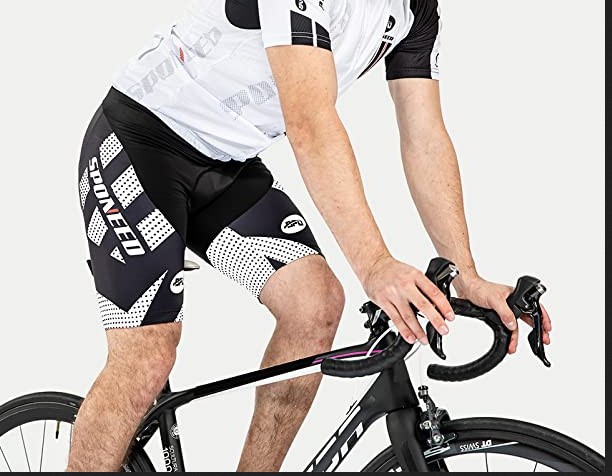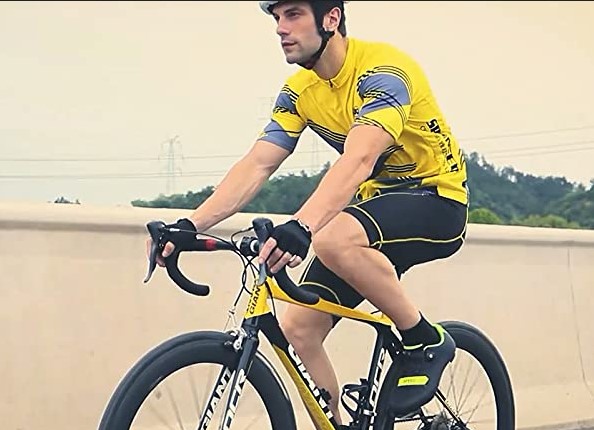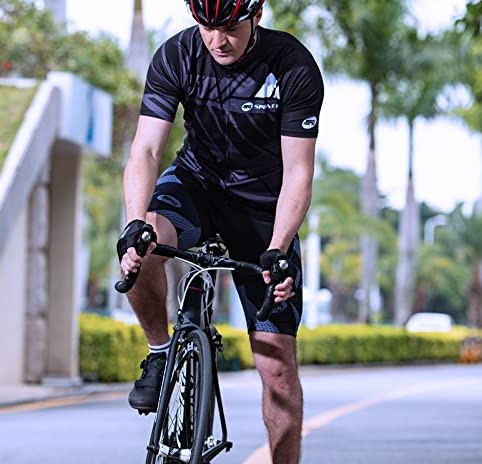There are numerous benefits for riding a bicycle, including strengthening cardiovascular health, reducing stress, enhancing joint mobility, lowering body fat, and reinforcing bones. However, this activity presents challenges and drawbacks, and today I aim to tackle one of them- is cycling bad for your balls?
Cycling isn’t bad for your balls, given that you do it well. Since testicles hang outside your body, they are at risk of getting injured by crushing pressure or a blow. Therefore, it’s paramount that you find the best bicycle seat and sitting position.
Nonetheless, you will likely experience a sensitive sensation, dull ache, or swelling on your balls after cycling if your saddle isn’t correctly fitted.
Generally, you should feel comfortable when cycling. This is achieved by investing in the right gear and setting your saddle correctly.

Can Riding A Bike Cause Testicular Pain?
Generally speaking, cycling shouldn’t cause pain in your balls, but that is not always the case. Sometimes you may feel soreness, numbness, pain, or swelling in your testicles after cycling, especially for a prolonged time or distance.
You risk hurting your balls if your saddle sits too low or too high. The bicycle’s saddle comes into direct contact with your perineum and the underlying structures, making them prone to damages if your balls are not positioned well.
The pressure subjected to your balls by the saddle impairs blood supply to your testicles and exerts pressure on the penis nerves. This causes testicular numbness, which is a common issue among male cyclists.
So, due to this, is cycling bad for your balls? Not necessarily, you can still enjoy riding your bicycle if you have the correct saddle, quality cycling shorts, and sit properly. I will explore these points in detail further in the post.
Why Do My Balls Hurt After Riding A Bike?
As stated above, while cycling isn’t necessarily bad for your balls, you might experience testicular pain while riding a bicycle if you sit badly (not upright) or use an uncomfortable saddle. Furthermore, you may be using low handlebars, or you might not be wearing padded cycling shorts.
It is vital to be aware of what could cause pain and discomfort when cycling. Doing so will help you avoid these causes and find joy riding without hurting your testicles.
Your saddle can cause severe problems to your balls when cycling, including:
1. Twisted Testicles
This occurs when your balls rotate excessively around your scrotum, limiting blood flow, resulting in excruciating pain and swelling.
While it is not often associated with cycling, visit the nearest emergency room immediately if you twist your balls when riding your bicycle.
2. Genital Numbness
An improperly placed saddle (too low or too high) causes genital numbness, usually caused by pudendal nerve entrapment or pudendal neuralgia (Alcock canal syndrome).
3. Testicular Trauma Or Nerve Injury
Nerve pain is the main culprit of testicular pain after cycling. It is caused by pudendal nerve irritation and is often experienced by long-distance cyclists because of the saddles and riding position.
You can alleviate nerve pain by assuming an upright cycling position and using a wider saddle. In addition, consider taking a break from riding until the pain dwindles.
A cycling accident or a bumpy ride can cause testicular trauma. For instance, mountain bikers can damage their balls from shock absorption when cycling on rugged terrains, leading to testicular torsion or testicular trauma.
You can hurt your testicles if you bruise or crush them while riding. This can tear the testicular covering, causing blood to leak into the scrotum or even testicular rupture if the tear is severe.

How To Protect Your Testicles When Cycling
Now that you know what can hurt your balls when cycling, it’s only fair that I cover the ways to protect them.
1. Get The Best Bike Seat For Your Balls (A Well-Sized Saddle)
The saddle is the main culprit causing pain and discomfort on your testicles when riding your bicycle. Therefore, it’s paramount to invest in the best bicycle seat for the sake of your genitals.
However, you are probably wondering how to spot the best bike seat. Simply go for a wider saddle because it exerts less pressure on your balls, thus providing more comfort and lowering the chances of hurting your testicles or experiencing numbness.
An excellent example of a quality, wide replacement saddle worth considering is the Bikeroo Oversized Bike Seat (amazon link) that is ergonomic, nimble, and has extra padding. It is compatible with exercise, peloton, and road bikes and is ideal for men and women.
A narrow bike seat puts a lot of pressure on your sitz bone, so it’s best to avoid such a saddle.
2. Position Your Bike Seat Well
You can also adjust the angle of the seat to relieve the pressure exerted on your genitals. Do this by loosening the saddle’s bolt screws and tip it a bit forward to transfer the center of gravity to your butt cheeks rather than the nucleus of your balls.
In addition, position your bike seat properly, ensuring your weight lies on the ischial tuberosities or pubic rami, depending on your posture’s roughness or aero dynamism. It is also essential to get a bicycle that fits you besides investing in a great seat.
3. Raise The Bars
Riding on low handlebars makes you lean forward, cutting off the blood supply to your genitals. Therefore, raise your bike’s bars to avoid losing sensitivity on your crotch.
4. Wear Proper Cycling Shorts
Your balls will be tucked in comfortably if you put on quality padded cycling shorts like Spooned Men’s Cycling Shorts (amazon link) before riding. These shorts are breathable, elastic, designed excellently, and have high-tech padding.
Bike shorts are made to suit your loins but ensure you go for one that feels comfortable and stays in place.
Additionally, it shouldn’t irritate your skin or set off hot spots. Moreover, under no circumstance should you wear underwear with your bike shorts.
5. Lubricate
Use chamois cream to lower friction created when your skin rubs against the cycling shorts. For maximum protection, apply some to the chamois and your skin before putting on the bike shorts.
6. Avoid Manscaping
While manscaping is a personal preference doing so presents an obstacle when you go bike riding. Shaving your pubes can cause irritated follicles, ingrown hairs, or razor bumps which are made severe by the friction generated by cycling.
If you must manscape, apply some antibiotic ointment on your skin (the affected area) if you are susceptible to irritating bumps and razor burns.

Is Cycling Bad For Your Balls? (Does Cycling Affect Male Fertility?)
When checking if cycling is bad for your balls, your fertility is a significant, if not the primary concern. You may have heard claims that riding causes erectile dysfunction and infertility.
Fortunately, that is not the case; cycling doesn’t affect fertility in males. In fact, there is no correlation between cycling and sperm count.
A July 2014 Journal of Men’s Health survey found no correlation between infertility or erectile dysfunction and cycling. This is regardless of the number of hours or miles one rides, including cyclists who clock 200 miles or 8.5 hours a week.
The survey involved over 500 cyclists (men) from the ages of 16 to 88. While this is excellent news for men who love to cycle, that does not mean you aren’t vulnerable to cycling complications or discomfort affecting your groin.
FAQs
1. Is Cycling Bad For Testicle?
Cycling is not bad for your testicles unless your ride on a narrow saddle or with low handlebars. Failure to put on padded cycling shorts can put your balls at risk of injuries or make you uncomfortable.
2. Can Cycling Cause Testicular Cancer?
While cycling has been presumed to contribute to or cause testicular cancer, there is no proven association between the activity and the disease.
3. Can Cycling Cause Testicular Cysts?
Cycling can cause scrotal cysts, benign tumors, and swelling. It is common for cyclists to develop small cysts; luckily, they aren’t troublesome and do not typically need treatment.
Bigger ones may cause discomfort, but they can be removed surgically.
4. Can Cycling Cause Testicular Lumps?
You can develop a firm, tender, soft-tissue nodule measuring about 3cm (1.1811 inches). This is caused by repeated friction and vibration between your ischial tuberosities when cycling.
The condition is called an accessory or third testicle.
5. Can Cycling Damage Your Testicles?
You can damage your testicles when cycling, but the activity itself does not cause harm to your balls. On the contrary, testicular damage from riding a bike stems from sitting on a narrow saddle that’s fitted low.
The constant pressure on your pudendal nerve leads to genital numbness, discomfort, or pain. The risk of damaging your balls increases if you cycle regularly, for many hours, or take part in mountain biking
6. Why Do My Balls Hurt When I Ride A Bike?
Your balls hurt when cycling because you use a narrow saddle, lean forward when riding, or position your seat at a wrong angle. In addition, you could be riding with low handlebars or not wearing proper gear.
7. Can Bike Riding Cause Testicular Torsion?
Bike riding can cause testicular torsion, although it is not typically associated with cycling. However, go to the nearest emergency room (ER) if you experience testicular torsion issues from riding a bicycle.
This problem occurs when your balls rotate around your scrotum, causing blood flow restrictions resulting in intense pain and swelling.
In Conclusion, Is Cycling Bad For Your Balls?
Many men have avoided cycling in the past for fear that it causes infertility and erectile dysfunction. However, scientists have refuted this misconception; thus, you are free to enjoy this fun activity without fear of hurting your sexual health.
Nonetheless, invest in the right bicycle, proper gear before hitting the trail to avoid issues like ball numb nuts, trauma, pain, discomfort, and nerve injuries.
